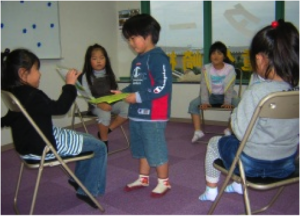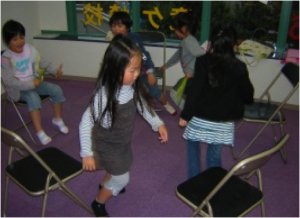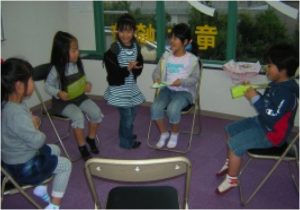It’s Magic: Creating Collaborative Games With Young Learners
– Marco Brazil
One of the best ways of getting kids collaborate is to have them create or reinvent a communicative game. Working together to design a game involves many skills including active decision-making and language practice in every skill area while giving them a sense of achievement and ownership. Creating games is also an excellent craft activity that can involve a lot of language use. The children can make their own dice, create cards, and design game boards based on rules they have agreed upon. Game making almost always excites the children. The project culminates on a day when the game is played.
Recently the six 8 and 9 year old in my class reinvented the classic Fruit Basket Game. I was the weather, practicing questions and answers like:
How’s the weather today?
It’s (sunny).
I handed out six white pieces of construction paper and asked each kid to draw a different picture of a type of weather. Deciding who would what became a big deal, so they decided to use rock-scissors-paper to work it out. Once they did that, it took them about 15 minutes to finish their drawings and write captions like:
It’s rainy. I don’t like a rainy weather.
Then I suggested we use the cards to play a game. Since there were only cards for six kinds of weather (sunny, rainy, cloudy, windy, snowy, and stormy), the kids figured out it would be impossible to play their all-time favorite Card Pairing Game. One of the kids suggested a variation on Fruit Basket Game but was unsure how to make it work. I asked them to discuss it and come to an agreement in five minutes time.
Here’s what they came up with:
1. There will be five chairs to form a big circle, spaced at a distance so that players can run easily.
2. The player who is it should stand at the middle of the circle. Shuffle the picture cards and place them face down on the floor with his/her eyes closed.
3. Players take a card but should not show it to other players.
4. The person who is it should ask a player; “How’s the weather, today?” If the player answers it’s rainy, it’s stormy, it’s windy, it’s cloudy, it’s snowy players should stay where they are and remain sitting. If the answer is It’s sunny everyone shouts Let’s go! then stands, runs, and quickly changes chairs.
5. The player left without a chair and still standing at the end should become the next person to be it.
There was heated discussion among the kids about which of the two weather conditions would be the signal to stand and change chairs: sunny or stormy. At first some members argued that it should be stormy weather, but other members of the class pointed out that you cannot play outside during stormy weather, and everyone agreed.
The class played the game with so much enthusiasm that they didn’t want to stop playing until their English time was up. They didn’t want to stop until I promised: “I will let you play it again next time, next week!”
The magic behind this enthusiasm is that it had became their game. Of course we can call it collaboration, but kids don’t need big words like that. All they need are opportunities to do it. Give your kids a chance to create a game of their own and you’ll be amazed at how far they take it. ~ Marco
Connect with Nina, John, Marco, Steven, Alexandra, James and other iTDi Associates, Mentors, and Faculty by joining iTDi Community. Sign Up For A Free iTDi Account to create your profile and get immediate access to our social forums and trial lessons from our English For Teachers and Teacher Development courses.
Like what we do? Become an iTDi Patron.
Your support makes a difference.






thx for documenting your classroom experience.
a great read on game design in education is here http://boingboing.net/2012/04/02/game-design-with-kids-an-inte.html. the video halfway down is particularly revealing.
the two main issues arising from my experience with univeristy student teams working on a semester long project are:
1. whether the topic interests them
2. the lines of communication they try (or not) to set up
3. recording their project progress
unfortunately the particular project i am involved with means students don’t get to choose the topic and if they don’t have any interest in it this can easily be seen in students motivation levels.
students who are interested in the topic also manage to communicate effectiviely with each other whereas others attempt to setup no means of communication unless they see each other during the course of their other studies.
so my role is to continually remind these teams them to communicate with each other, and also to record the progress of their project.
ta
mura
Hi, Mura!
Thanks for sharing us your thoughts. For sure other teachers will gain knowledge from your experience.
And the link is so informative.
Marco
sorry to go slightly offtopic from the ‘collaboration’ but this post – http://shawncornally.com/wordpress/?p=2499 on getting students to revise a game based on evolution and genetics is quite a good illustration of getting students to be involved in class.
thanks
mura
What a delightful game!
Thank you for explaining so clearly the different stages and how the students settled disputes (rock-scissors-paper). That was the first thing I would have asked – when having the students decide things they need a civilized way to settle disputes!
You certainly shared the magic with us!
Great post!
Naomi
When it comes to solving disputes? My students always find ways, they always surprised me!
Thanks for dropping by Naomi.
Marco
Dear Marco,
We have met before but I’ve actually forgotten where. Anyway Bill Pellowe has passed me a message that you will be doing a presentation on October the 8th.
I will post a 100 CAPTUR paddles to you today and I have also taken the liberty of sending you a couple of Intercom Press texts.
When you next come to Fukuoka please let me know so I can invite you over to my home/office for a meal and chat.
Kind regards,
Paul Shimizu
Hi Marcos,
What a great post! Thanks for sharing with us practical tips and tools on how to foster collaborative work. It is very inspiring how you managed to engage young children in devising games in the classroom. That’s a cool experiance that I would like to try in my class, but I wonder how I could do that especially that my students are teenagers not children; so, I’m not sure whether they will respond positively to the idea or not! If you have any ideas about implementing that with teens, please do share them. Thanks in advance!
Regards,
Samir
wow! That was something that I never imagined.It is amazing the way the got the kids to do things. It is a wonderful game and it sounds like a similar one the people play here, but in parties for kids, but with music being payed and stopped where the last child left standing is out. This is a game worth trying, and I will in my next class with kids. Thanks for sharing.
Thank you for sharing. I always think that if I let my students decide the class will get out of control. But having read your post, I guess I should give it a try some time to see how things are. I always feel afraid that I can’t handle the children if I just let them decide the kinds of game and how to play the game.
Thanks lot I remember at the kindergarden or at the elementary school we played this game in my native language We also put 5chairs,made a circle, were walking around the chairs But I dont remember what we said, when we sat on a chair, how it happened that one stayed without a chair:) Thanks to remind me I will ask someone about this game
Dear Marco,
By choosing the learner-centered approach, you must be satisfied with your students getting out of situation by themselves. You encourage that. When they refer to you as they think they don’t know how to continue, instead of giving the solution you tell them to solve the issue collaboratively. Doing so you increase their creativity, confidence, will, sense of sociability and ownership. Thank you for the tremendous success!
Hello, Marco!
I read some of your posts on teachervillage, and I was following the slideshow in the iTDi MOOC. I have teenager students who are always willing to play games, but I have a hard time coming with new things because I don’t have much time, but your explanation about how your little kids came up with their own version is really great.
I was thinking of using a card deck with the parts of speech, and play sort of scrabble, but instead of forming words, they would form sentences…the correct and longest ones receiving one point per word.
Another game could be a sentence relay.
Marco,
Great idea. I like that this idea builds on child-led learning. Children don’t always know HOW to do WHAT they WANT and this is where we come in. In my class, our games are always evolving. Students often want to try variations of the same game. I realize this means that all students are able to get some of the elements down. Thanks for sharing.